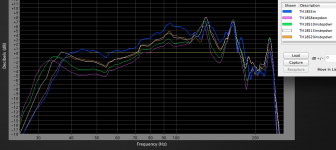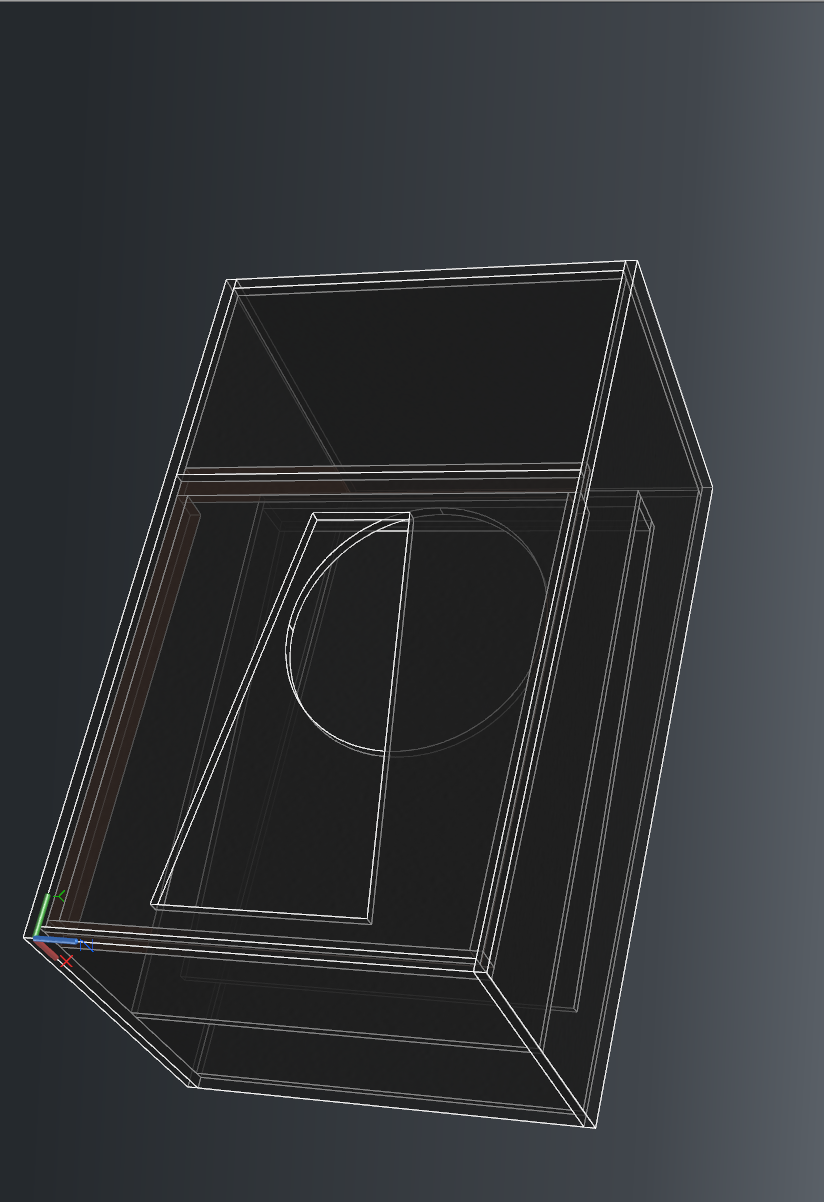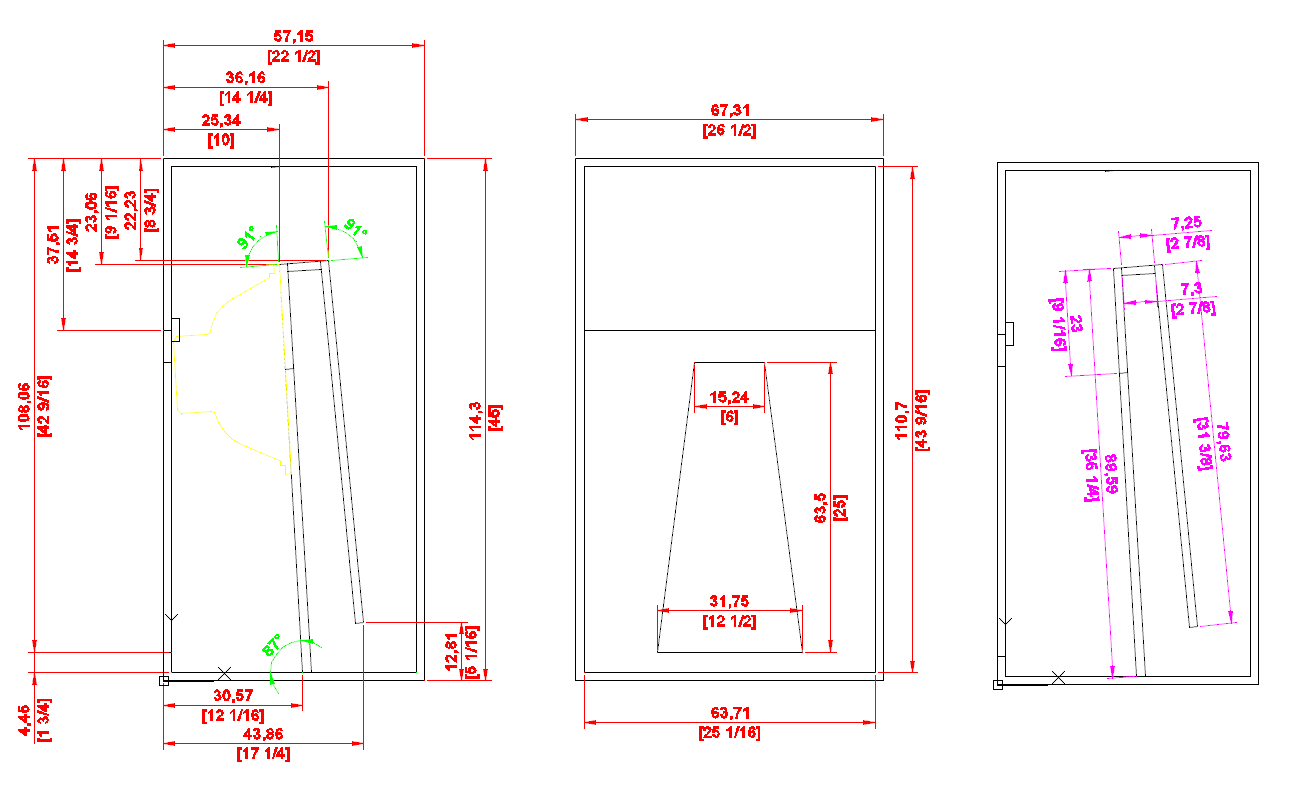Shaun,Damn, your awesome man!I Thanks. And thanks Art for allowing this to happen. I'm going to look over the grafs better when I get home from work.
The simulation EPA posted in #248 shows a lower response than the actual measured response of the Keystone, which starts to roll off just below 40 Hz. Since the excursion minima is around 36 Hz, EQing the response flat in that range is no problem, but boosts below 32 Hz will end up increasing harmonic distortion quite a bit as excursion rises rapidly.
One interesting aspect of the Keystone design is the Fb can be lowered by simply covering the upper portion of the exit, the measurements below show the difference between the normal size exit, "TH18S3m", and covering up the upper portion of the exit, "TH18S20" has the upper 20 inches of the exit covered with plywood. The "step down" cover results in as much as an 8 dB increase in 30 Hz level, but with progressive losses in the upper bass range, so for most music the trade off is not worth the extension.
The RTA 420 mic used for those tests reads -2 dB low at 30 Hz, so LF response is actually 2 dB better than indicated.
Art
Attachments
If I advance pink noise slowly, dogs don't seem to notice, but sine wave sweeps or tones always make them bark like crazy!LOL - Pink noise, or sine sweep, and how long was each measurement signal?
Fortunately at the levels I generally test at, their barking is at least 60 dB down from the test tones :^).
Last edited:
Shaun,
The simulation EPA posted in #248 shows a lower response than the actual measured response of the Keystone, which starts to roll off just below 40 Hz. Since the excursion minima is around 36 Hz, EQing the response flat in that range is no problem, but boosts below 32 Hz will end up increasing harmonic distortion quite a bit as excursion rises rapidly.
One interesting aspect of the Keystone design is the Fb can be lowered by simply covering the upper portion of the exit, the measurements below show the difference between the normal size exit, "TH18S3m", and covering up the upper portion of the exit, "TH18S20" has the upper 20 inches of the exit covered with plywood. The "step down" cover results in as much as an 8 dB increase in 30 Hz level, but with progressive losses in the upper bass range, so for most music the trade off is not worth the extension.
The RTA 420 mic used for those tests reads -2 dB low at 30 Hz, so LF response is actually 2 dB better than indicated.
Art
So Art, if I increase the Keystone measurements hight by 4" and the width by 5" we will get a roll off just below 35hz and loose only 2-3db with the B&C 21SW152-4 driver, (which looks to be out of stock until 9/19)? Also with this cabinet extension, the Keystone exit stays the same, right? And after reading about the Keystone covering of the upper portion of the exit lowering the Fb, which leads to progressive losses in the upper bass range, I too think that the trade off is not worth the extension. I hate trade offs, when loosing db's or bandwidth.
The sound engineer at church says he would like a 25hz extension, but I think he really doesn't know what he is asking for. I can see that in car audio, home theater, or just showing off. But what would you need 25hz in a church environment for? It's live sound, bass, guitar, drums, and electronic keyboard. I think he would be happy with a well designed cab with high efficiency, high output, and as you have done 5hz lower than the norm of 40hz, what do you think?
PS thanks epa!
Shaun
the simulation is wat is just a simulation.
in my sim i used the dimensions from oliver(tb 46) .
the only diference making the first section slightly tappered from 3.5"to 4"
most people don't know how low 40 hz is,
for example ,lowest note on a for string bass is around 40,
and also harmonics are importaint.
i would bild the keystone as is .
in my sim i used the dimensions from oliver(tb 46) .
the only diference making the first section slightly tappered from 3.5"to 4"
they keystone go's plenty deep for you purpose.The sound engineer at church says he would like a 25hz extension, but I think he really doesn't know what he is asking for. I can see that in car audio, home theater, or just showing off. But what would you need 25hz in a church environment for? It's live sound, bass, guitar, drums, and electronic keyboard. I think he would be happy with a well designed cab with high efficiency, high output, and as you have done 5hz lower than the norm of 40hz, what do you think?
most people don't know how low 40 hz is,
for example ,lowest note on a for string bass is around 40,
and also harmonics are importaint.
i would bild the keystone as is .
Appears to be identical to the original plan.am i getting close art?
Shaun,1)So Art, if I increase the Keystone measurements hight by 4" and the width by 5" we will get a roll off just below 35hz and loose only 2-3db with the B&C 21SW152-4 driver, (which looks to be out of stock until 9/19)?
2)Also with this cabinet extension, the Keystone exit stays the same, right?
3) But what would you need 25hz in a church environment for?
4)I think he would be happy with a well designed cab with high efficiency, high output, and as you have done 5hz lower than the norm of 40hz, what do you think?
1) Sounds about right, but given more power, the increased cone area of the 21" should about equal the output of the 18" and go lower.
2) No, it probably should be scaled up approximately by the percentage of cabinet volume increase.
3) Pipe organs going down to 16 Hz have been used in churches for centuries.
4) Comparing the response of the Keystone to headphones that have response down to 9 Hz, I seldom hear any missing low notes in any of the music I play, or even in the music of the few EDM DJs I have worked with. I designed the Keystone as the optimum low extension vs. size, and wanted something that can do justice to the low B on a 5 string bass (31 Hz). That said, there are keyboard patches and musical genres that have output deeper than the Keystone's range, and other larger cabinets that can reach lower for those willing to build them.
Art
Hi Art, Mark W here.....
What's your guess on the number of Keystones it would take to match my 4 labhorns, before the labhorns heat up? From say 35 to 80 hz?
The keystone looks so easy to build I'm thinking of cranking out 1....
I'm giving thought to the Xoc1 TH-18 and othorn too, but it's hard for me to see how the build complexity of the Xoc1 is worth it vs the keystone, or even how much performance difference I expect between the two.
The othorn is a different animal it seems...and still looks a heck of alot easier to build than a labsub
Im thinking it might be the way to go for a truly new low end experience....
What's your guess on the number of Keystones it would take to match my 4 labhorns, before the labhorns heat up? From say 35 to 80 hz?
The keystone looks so easy to build I'm thinking of cranking out 1....
I'm giving thought to the Xoc1 TH-18 and othorn too, but it's hard for me to see how the build complexity of the Xoc1 is worth it vs the keystone, or even how much performance difference I expect between the two.
The othorn is a different animal it seems...and still looks a heck of alot easier to build than a labsub
Im thinking it might be the way to go for a truly new low end experience....
4 TH18 (TBW100 loaded) = about 3 labhorns. In initial impact I have to give the edge to the 3 labs, but after 4 hours of thumping and bumping those B&C's sill sound the same and the labs start dropping. The 4 TH18 are a lot easier to load in and out, and the tops fit in the truckbed with them. TH18 and Keystone will be comparable in output and extension. I wanted something with a traditional horn mouth - for when the stack gets large and I want to experiment with V-coupling and flare extensions.
If you want to keep the labs cool you need 8. 8 also lets you do 2 stacks with flare extensions - which produces insane bass. The Othorn looks very interesting, but I can't help but wonder what could be done in a LAB / 12pi form factor with the 21's in them.
If you want to keep the labs cool you need 8. 8 also lets you do 2 stacks with flare extensions - which produces insane bass. The Othorn looks very interesting, but I can't help but wonder what could be done in a LAB / 12pi form factor with the 21's in them.
Mark,What's your guess on the number of Keystones it would take to match my 4 labhorns, before the labhorns heat up? From say 35 to 80 hz?
The keystone looks so easy to build I'm thinking of cranking out 1....
The othorn is a different animal it seems...and still looks a heck of alot easier to build than a labsub
Im thinking it might be the way to go for a truly new low end experience....
Wg_ski's post seems pretty spot on to me, though using BC18SW115 or the more sensitive BC18TBW100 in the Keystone may be closer to 1 to 1 after power compression is factored in (PASC built and compared the Keystone to the TH18 and found the Keystone to have about 2 dB more output), but will require more power to achieve the same level as the Labhorns. In all honesty, the low end experience won't be "new", just will require about half the storage space to achieve.
A good test would be to build the Keystone for an 18", then make an adapter plate for two of your Lab 12s to fit in (or I could give you the one I have for shipping costs) and do a comparison. The Lab12s in the Keystone will heat less than in the Labhorn, if you found them close in output to the Labhorn, you could count on about 4 dB more ultimate output with the B&C drivers (using more power) due to less thermal compression.
As far as the Othorn, given more power, it has slightly more output level than the Keystone, but is larger and heavier, uses a more expensive driver, and goes about 8 Hz lower. For 95% of the music I play, there would be little difference, but for some EDM, the extension would be apparent in an A/B test.
Art
Last edited:
Thanks Wg_ski, thanks Art,
What you guys are saying seems very consistent with the impressions I've gathered from pouring through the threads.
I guess reduced size and thermal handling are the big advantages of doing something, vs what I already have...
Wg_ski, I was actually hoping that the ratio might go the other way, 3 of either the TH18s or the Keystones: to 4 Labs ... but the numbers posted kinda let me know that was probably wishing thinking.. or at least before the labs heat up...
I guess I'm just looking for an excuse to make sawdust again !
When you put 4 labs in a stack, what flares did you put on?
And Yes, today's drivers in a re-engineered 12pi labhorn ?...the box might be as huge as no tomorrow, but oh Yea !!
Art, thanks for the offer on the adapter plate...I'll definitely take you up on it if I take off on the keystone. But then again, I know damn well I wont be able to keep from getting the BC18SW115 when I start building the cabinet
I saw PASC's posts....very encouraging... thx again for sharing your design.
Mark
What you guys are saying seems very consistent with the impressions I've gathered from pouring through the threads.
I guess reduced size and thermal handling are the big advantages of doing something, vs what I already have...
Wg_ski, I was actually hoping that the ratio might go the other way, 3 of either the TH18s or the Keystones: to 4 Labs ... but the numbers posted kinda let me know that was probably wishing thinking.. or at least before the labs heat up...
I guess I'm just looking for an excuse to make sawdust again !
When you put 4 labs in a stack, what flares did you put on?
And Yes, today's drivers in a re-engineered 12pi labhorn ?...the box might be as huge as no tomorrow, but oh Yea !!
Art, thanks for the offer on the adapter plate...I'll definitely take you up on it if I take off on the keystone. But then again, I know damn well I wont be able to keep from getting the BC18SW115 when I start building the cabinet
I saw PASC's posts....very encouraging... thx again for sharing your design.
Mark
Although the thermal capability of the 18SW115-4 is likely better than the LAB12's the real advantage is that the motor out TH configuration sheds heat so well the motor's stay relatively cool if you have any headroom left on the amps. By that I mean I've personally fed my test TH18 cab loaded with 18SW115-4 over 370v p-p and unless it's EDM the driver is barely warm to the touch, maybe 10-15 degees F above ambient. EDM duty cycle where the coil is dissipating 300-500 watts average obviously makes significant heat, but as long as you don't do anything stoopid you are OK. I would expect Art's Keystone to probably shed heat even better.
- Home
- Loudspeakers
- Subwoofers
- Keystone Sub Using 18, 15, & 12 Inch Speakers



